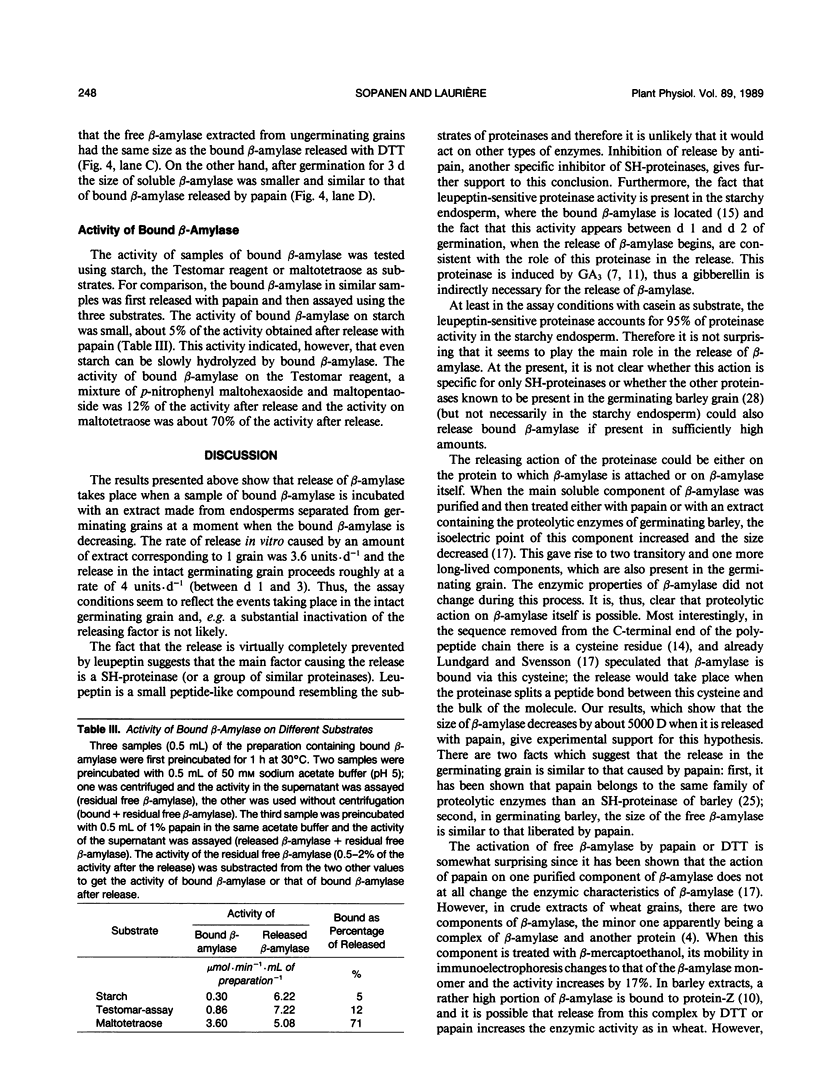Abstract
In resting grains of Triumph barley (Hordeum vulgare L. cv Triumph) about 40% of the β-amylase could be extracted with a saline solution, the remaining 60% being in a bound form. During seedling growth (20°C), the bound form was released mainly between days 1 and 3. When a preparation containing bound β-amylase was incubated with an extract made of endosperms separated from germinating grains, release of bound β-amylase took place and could be studied in vitro. The release was almost completely prevented by leupeptin and antipain, specific inhibitors of a group of SH-proteinases, but it was not inhibited by pepstatin A or EDTA, which inhibit some other barley proteinases. It is thus very likely that in a whole grain, at least the bulk of the bound β-amylase is released by the proteolytic action of one or several SH-proteinases. When the bound β-amylase was released by papain, its molecular weight was about 5000 daltons smaller than that of β-amylase released by dithiothreitol. This indicates that the release is due to removal of a sequence of β-amylase itself. A similar decrease in size took place during seedling growth. Bound β-amylase showed some activity against native starch and it hydrolyzed maltotetraose at a rate that was about 70% of the rate the same amount of bound β-amylase gave after release. Bound β-amylase is thus not inactive and it is likely that the slower rate of hydrolysis is due to steric hindrances which prevent substrates from reaching the active site.
Full text
PDF





Images in this article
Selected References
These references are in PubMed. This may not be the complete list of references from this article.
- Daussant J., Skakoun A. Immunochemical approaches to studies of isozyme regulation in higher plants. Isozymes Curr Top Biol Med Res. 1981;5:175–218. [PubMed] [Google Scholar]
- Hammerton R. W., Ho T. H. Hormonal regulation of the development of protease and carboxypeptidase activities in barley aleurone layers. Plant Physiol. 1986 Mar;80(3):692–697. doi: 10.1104/pp.80.3.692. [DOI] [PMC free article] [PubMed] [Google Scholar]
- Jacobsen J. V., Varner J. E. Gibberellic Acid-induced synthesis of protease by isolated aleurone layers of barley. Plant Physiol. 1967 Nov;42(11):1596–1600. doi: 10.1104/pp.42.11.1596. [DOI] [PMC free article] [PubMed] [Google Scholar]
- King J., Laemmli U. K. Polypeptides of the tail fibres of bacteriophage T4. J Mol Biol. 1971 Dec 28;62(3):465–477. doi: 10.1016/0022-2836(71)90148-3. [DOI] [PubMed] [Google Scholar]
- Kreis M., Williamson M., Buxton B., Pywell J., Hejgaard J., Svendsen I. Primary structure and differential expression of beta-amylase in normal and mutant barleys. Eur J Biochem. 1987 Dec 15;169(3):517–525. doi: 10.1111/j.1432-1033.1987.tb13640.x. [DOI] [PubMed] [Google Scholar]
- Niku-Paavola M. L., Skakoun A., Nummi M., Daussant J. The polymorphism of barley beta-amylase. Biochim Biophys Acta. 1973 Sep 21;322(1):181–184. doi: 10.1016/0005-2795(73)90191-8. [DOI] [PubMed] [Google Scholar]
- Paleg L. G. Physiological Effects of Gibberellic Acid: I. On Carbohydrate Metabolism and Amylase Activity of Barley Endosperm. Plant Physiol. 1960 May;35(3):293–299. doi: 10.1104/pp.35.3.293. [DOI] [PMC free article] [PubMed] [Google Scholar]
- Ranki H., Sopanen T. Secretion of alpha-amylase by the aleurone layer and the scutellum of germinating barley grain. Plant Physiol. 1984 Jul;75(3):710–715. doi: 10.1104/pp.75.3.710. [DOI] [PMC free article] [PubMed] [Google Scholar]
- Rogers J. C., Dean D., Heck G. R. Aleurain: a barley thiol protease closely related to mammalian cathepsin H. Proc Natl Acad Sci U S A. 1985 Oct;82(19):6512–6516. doi: 10.1073/pnas.82.19.6512. [DOI] [PMC free article] [PubMed] [Google Scholar]
- Towbin H., Staehelin T., Gordon J. Electrophoretic transfer of proteins from polyacrylamide gels to nitrocellulose sheets: procedure and some applications. Proc Natl Acad Sci U S A. 1979 Sep;76(9):4350–4354. doi: 10.1073/pnas.76.9.4350. [DOI] [PMC free article] [PubMed] [Google Scholar]



